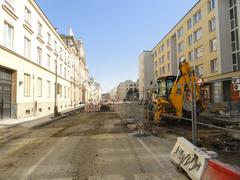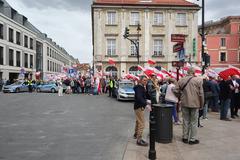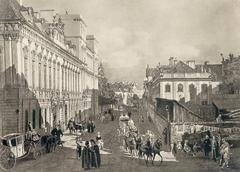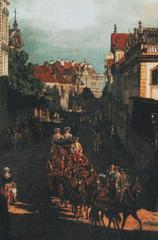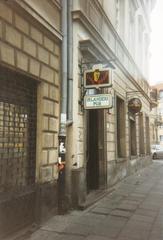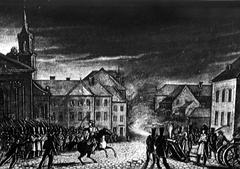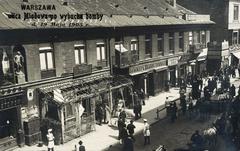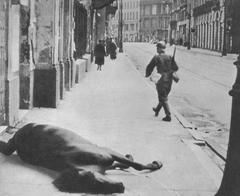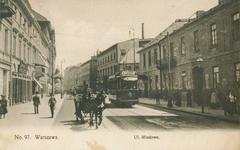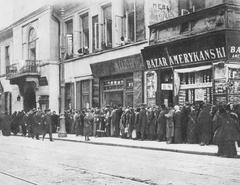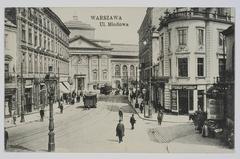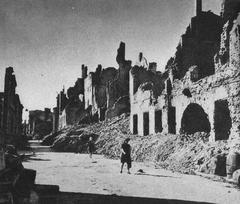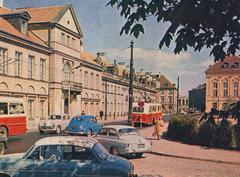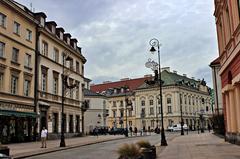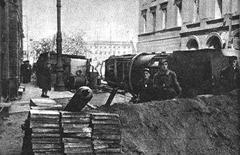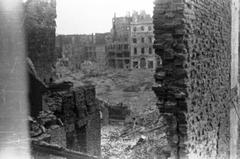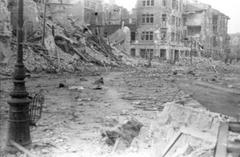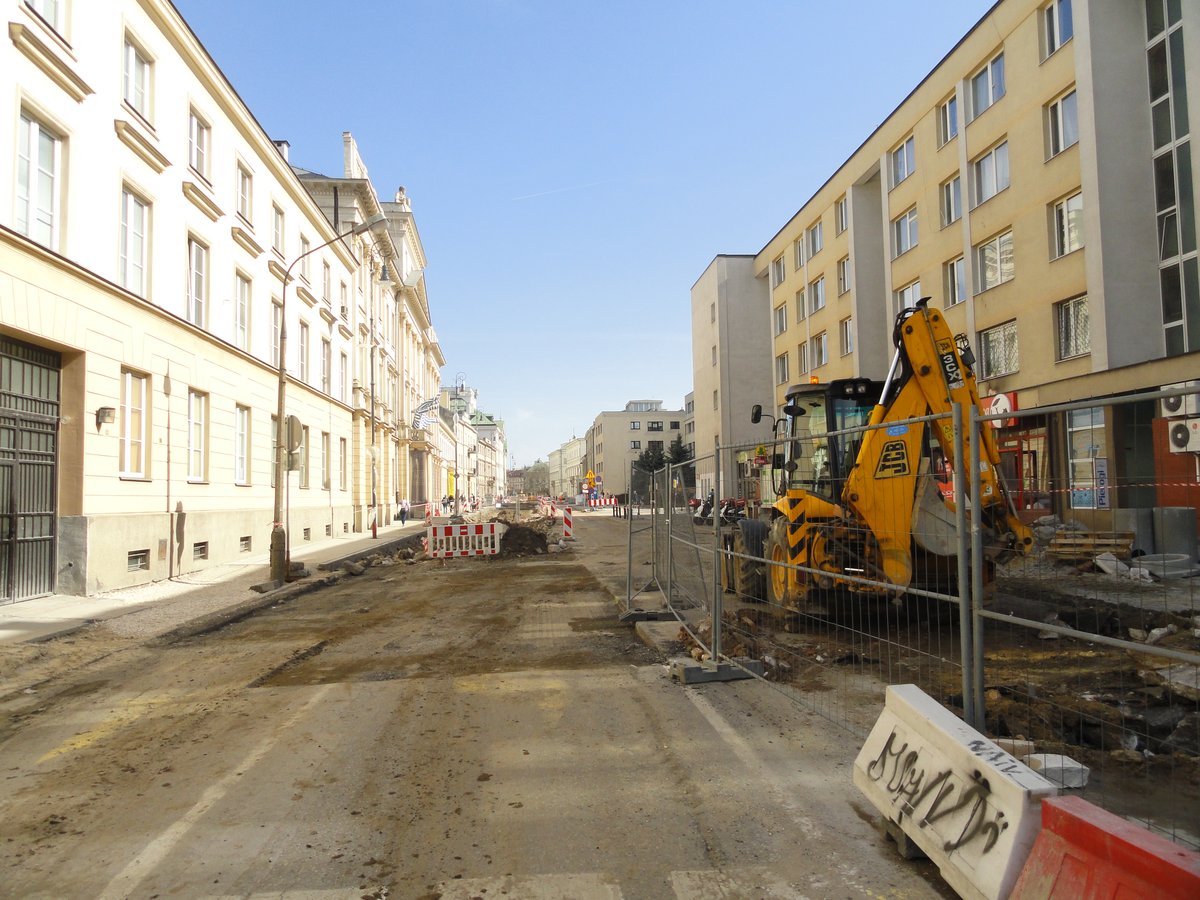
Miodowa Street Warsaw: Visiting Hours, Tickets, and Historical Sites Guide
Date: 14/06/2025
Introduction
Miodowa Street, known in Polish as “Ulica Miodowa” or “Honey Street,” is a historic artery in Warsaw’s Old Town that encapsulates centuries of architectural splendor, cultural evolution, and the enduring resilience of the Polish capital. Once a commercial hub famed for its honey and gingerbread merchants in the 16th century, Miodowa swiftly became a prestigious address for nobility, clergy, and merchants. Its strategic placement along the Royal Route places it at the intersection of Warsaw’s historical narrative, connecting landmarks such as the Royal Castle and Krasiński Square (Wikipedia).
Rebuilt after the devastation of World War II and recognized as part of a UNESCO World Heritage Site, Miodowa Street today is a vibrant urban corridor blending Baroque, Neoclassical, and post-war architecture. Its prominent landmarks—such as the Palace of Crown Marshal Jan Klemens Branicki, the Palace of the Bishops of Kraków, the Church of the Capuchins, and the Lelewel Palace—offer a living testimony to Warsaw’s layered past (artsandculture.google.com).
This comprehensive guide provides all essential information for visitors, including opening hours, ticketing policies, accessibility, travel tips, and insights into the ongoing architectural debates that shape Miodowa’s unique character.
For more details and updates, visit the Warsaw Tourism Office and explore Canaletto’s historic paintings on Google Arts & Culture. The latest news on renovations and accessibility can be found on the City of Warsaw’s official portal.
Historical Overview
Origins and Early Development
Emerging in the 16th century, Miodowa Street derived its name from the honey and gingerbread shops once lining its thoroughfare (Wikipedia). Its evolution into a desirable residential and ceremonial route was propelled by its position between Krakowskie Przedmieście and Krasiński Square, making it an integral segment of Warsaw’s Royal Route (artsandculture.google.com).
Architectural and Cultural Landmarks
Miodowa Street’s illustrious past is reflected in its striking architecture, immortalized in 18th-century paintings by Bernardo Bellotto (Canaletto). Notable landmarks include:
- Palace of Crown Marshal Jan Klemens Branicki (1740): This Baroque edifice stands as a symbol of aristocratic power (Wikipedia).
- Palace of the Bishops of Kraków (1622, rebuilt 1760–1762): Renovated by Jakub Fontana, this palace was a residence for Kraków’s bishops.
- Church of the Capuchins (1683–1694): Founded by King John III Sobieski and housing his heart urn, this church is an architectural and spiritual highlight.
- Lelewel Palace: Designed by Efraim Szreger, significant for its neoclassical features.
- Mansion of Piotr Tepper (1774): Once home to the royal banker, destroyed in WWII and not rebuilt.
19th and Early 20th Centuries
Industrialization and modernization marked the 19th and early 20th centuries, with archaeological discoveries such as an early brick canal and the introduction of an electric tram line in 1908 (en.um.warszawa.pl). The townhouse at 3 Miodowa Street, constructed in 1912, showcased early modernist influences (whitemad.pl).
Destruction and Postwar Reconstruction
World War II inflicted extensive damage, with many historic buildings lost or severely damaged. The street’s postwar reconstruction, led by architects like Bronisław Iwańczyk, favored a classicizing style that respected the historic context while providing for contemporary needs (sah.org). The Old Town, including Miodowa Street, was awarded UNESCO World Heritage status for the fidelity and vision of this reconstruction (nomadicmatt.com).
Cultural Significance and Notable Figures
Miodowa Street has been at the center of Warsaw’s political, artistic, and social life. Figures such as King John III Sobieski, Canaletto, and Jan Klemens Branicki are closely linked to its history. The street also witnessed pivotal moments, including the 1905 Revolution (sah.org).
Visiting Miodowa Street: Practical Information
Visiting Hours and Tickets
- Miodowa Street: Open to the public 24/7, year-round, with no entrance fee.
- Landmarks:
- Church of the Capuchins: Typically open daily from 9:00 AM to 6:00 PM; free entry.
- Palace of the Bishops of Kraków: Entry may be limited due to institutional use; check local listings.
- Museums nearby (e.g., Museum of Warsaw, POLIN Museum): Usually open 10:00 AM to 6:00 PM; tickets required (Touropia).
Tip: Always check the official websites or Warsaw Tourism Office for the latest opening hours and ticket information.
Accessibility
Ongoing renovations are enhancing Miodowa Street’s accessibility with granite pavements, tactile paving, and guiding strips for visually impaired visitors (City of Warsaw). While cobblestones remain, improved sidewalks and cycle lanes facilitate access for wheelchairs and strollers. Some historic buildings may have limited accessibility.
Guided Tours and Special Events
Numerous walking tours feature Miodowa Street as a highlight of Warsaw’s Old Town. Tours can be booked through local providers or online and often include in-depth historical and architectural commentary. The street also hosts events during city festivals, such as open-air concerts and markets.
Travel Tips
- Wear comfortable shoes for cobblestone streets.
- Visit in the morning for a quieter experience.
- Combine your visit with nearby attractions (Royal Castle, Old Town Market Square).
- Monitor renovation schedules for any access restrictions (City of Warsaw).
Architectural Landmarks and Historical Buildings
- Palace of the Bishops of Kraków: Baroque architecture, now housing the Polish Academy of Sciences. Exterior accessible daily; interior visits by appointment.
- Branicki Palace: Baroque design, now the Ministry of Health. The garden and exterior are accessible during daylight.
- Capuchin Church: Open for visitors daily, renowned for its serene interiors and the tomb of King John III Sobieski.
- Lelewel Palace: Neoclassical building, can be admired from outside.
- Jan Kiliński Monument: A tribute to the 1794 uprising leader, located at the southern end of the street.
Religious and Cultural Sites
- Church of the Holy Spirit: Baroque church with impressive frescoes and altars, open during services.
- Jewish Heritage Sites: Memorial plaques commemorate the pre-war Jewish community. The nearby POLIN Museum is open Tuesday to Sunday, 10 AM to 6 PM (tickets required).
Museums and Cultural Institutions Nearby
- Museum of Warsaw: Offers exhibits on the city’s history, open daily, tickets required.
- POLIN Museum of the History of Polish Jews: A globally renowned museum, 15 minutes on foot from Miodowa.
Gastronomy, Shopping, and Urban Experience
- Restaurants: Traditional Polish eateries and cafes line Miodowa and adjacent streets, generally open 11 AM to 10 PM.
- Shops: Boutiques and souvenir shops operate from 10 AM to 7 PM.
- Street Life: In warmer months, markets, festivals, and street performers enliven the area.
Architectural Controversies and Urban Development
Postwar Reconstruction and Modern Interventions
After WWII, Miodowa’s reconstruction balanced restoration with new urbanist principles, creating open courtyards and green spaces (Muzeum Warszawy). This has sparked debates about historical authenticity.
“Castle Square – Business with Heritage” Complex
The office complex at Plac Zamkowy, completed in 2015 near Miodowa, remains controversial for its modern design adjacent to UNESCO-listed areas (WhiteMAD). Its attempt to echo historic forms has led to debates about architectural integration and heritage protection.
Broader Trends in Warsaw’s Architectural Heritage
Warsaw’s approach blends “new old” reconstructions with adaptive reuse, as seen in projects like Centrum Praskie Koneser and the relocated Emilia Pavilion (Culture.pl, Parametric Architecture).
Miodowa Street Renovation and Public Consultation
Recent upgrades, chosen after public consultation, prioritize historical continuity with Krakowskie Przedmieście, stone pavements, stylized lampposts, and widened sidewalks (UM Warszawa). Traffic calming and greenery enhance pedestrian comfort.
Community Reactions and Ongoing Debates
Urban renewal on Miodowa Street has prompted discussion about balancing economic development, urban vitality, and the preservation of authenticity (Culture.pl).
Frequently Asked Questions (FAQ)
Q: Is there an entrance fee to Miodowa Street?
A: No, it is a public street, accessible 24/7.
Q: Are tickets required for museums and historical sites?
A: Some sites and museums require tickets; check official websites.
Q: Are guided tours available?
A: Yes, many guided tours include Miodowa Street and can be booked online or locally.
Q: Is the street wheelchair accessible?
A: Renovations have improved accessibility, but some cobblestone sections and historic buildings may present challenges.
Q: What are the best times to visit?
A: Spring through early autumn is ideal for weather and events.
Summary and Recommendations
Miodowa Street is a remarkable destination for exploring Warsaw’s architectural and cultural history. Open year-round and free to visit, it features iconic landmarks, museums, restaurants, and lively urban experiences. The recent renovations underscore Warsaw’s commitment to accessibility and heritage preservation, even as debates over new developments continue.
For the best experience:
- Plan your visit using up-to-date information from official sources.
- Consider a guided tour for deeper insights.
- Use the Audiala app for self-guided tours and insider tips.
Miodowa Street offers a journey through Warsaw’s past and present—walk its cobblestones, explore its palaces and churches, and become part of the city’s living history.
Further Reading and Official Resources
- Miodowa Street, Warsaw Wikipedia, 2024
- Miodowa Street on Google Arts & Culture, 2024
- The Old Times: Warsaw under Krasiński’s Square, City of Warsaw, 2024
- Architectural Reproduction vs. Reconstruction in Postwar Warsaw, SAH Blog, 2021
- It Used to Have Seven Floors: The Townhouse at 3 Miodowa Street, WhiteMAD, 2024
- Nomadic Matt’s Poland Travel Guide, 2024
- Miodowa Street About to Change: An Agreement Has Been Signed, City of Warsaw, 2024
- The Office Building That Divided Varsovians: Controversial Investment in the Old Town Turns 10 Years Old, WhiteMAD, 2025
- New Old Buildings: Warsaw’s Controversial Contemporary Reconstructions, Culture.pl, 2024
- Warsaw Architecture Guide: 6 Modern Structures to See, Parametric Architecture, 2024
- New Ulica Miodowa, City of Warsaw, 2024
- Touropia’s guide
- The Thorough Tripper
- The Unique Poland
